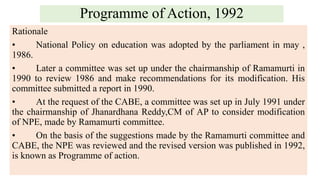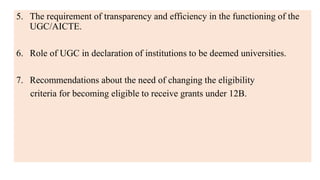The Kothari Commission report of 1964-66 laid out guiding principles for educational reconstruction in India, including introducing work experience and social service into education, vocationalization of secondary education, strengthening advanced study centers, special emphasis on teacher training, and prioritizing agricultural education. It established task forces on various levels and aspects of education. The Programme of Action in 1992 aimed to establish a national system providing comparable quality education to all students regardless of attributes. It focused on quality, pacesetting schools, vocationalization, research-driven higher education, and evaluation methods. The Yashpal Committee report reviewed teacher education and recommended reducing academic burden on students through more joyful, experience-based learning and addressing the roots of curriculum issues.













![• Learning to Know
• Learning to do
• Learning to Be
• Learning to Live together
[Each individual to learn how to learn; Each individual
would be in turn both Teacher and Learner- Learning
Society]
Four Pillars of Education](https://image.slidesharecdn.com/chellamanimam-220520142824-23fb6390/85/Commissions-14-320.jpg)
















